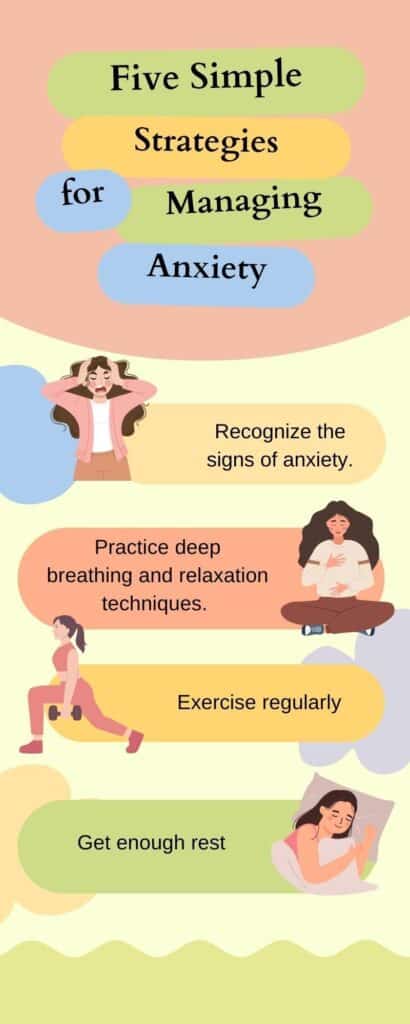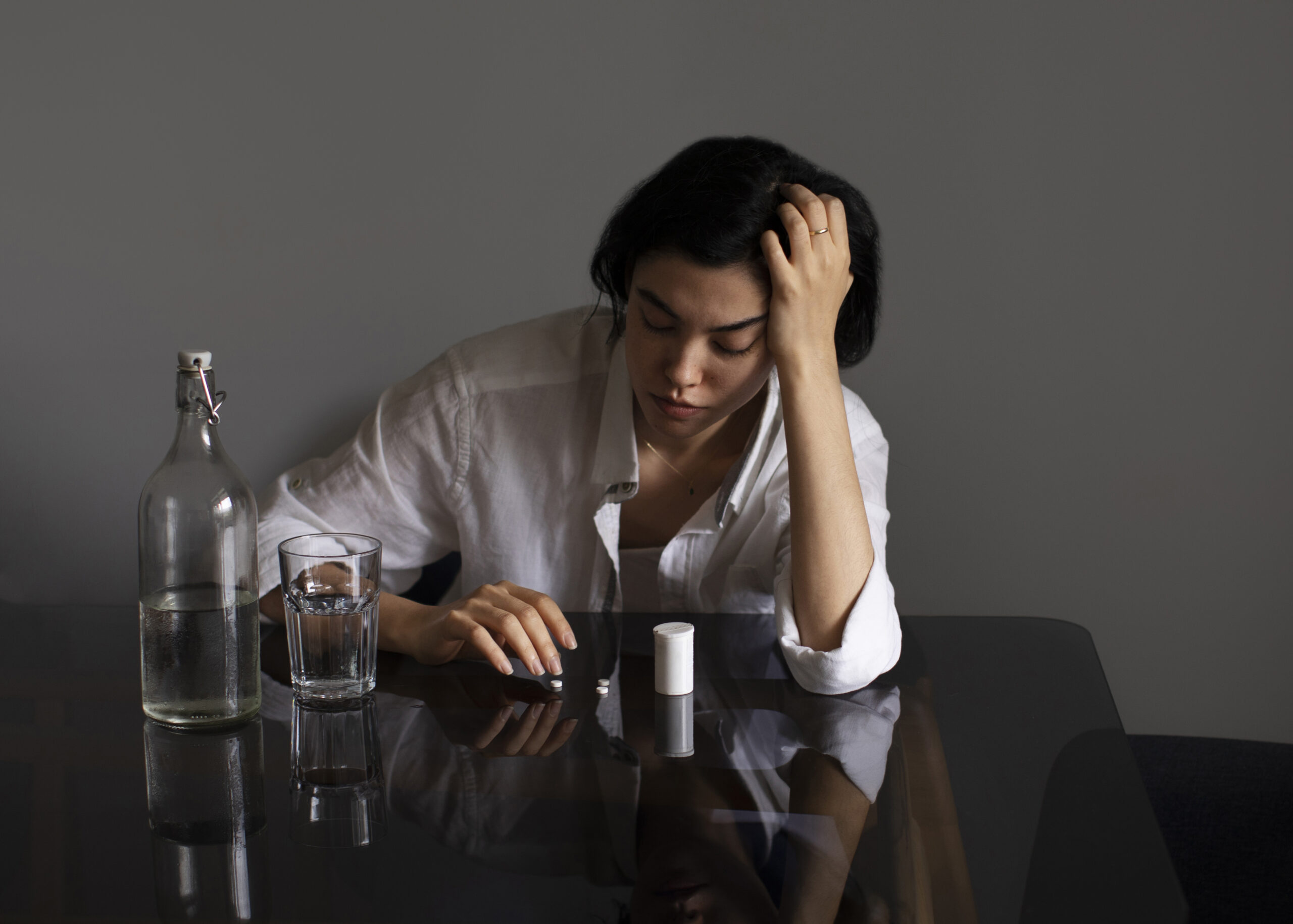Is your teenager grappling with anxiety? As a parent, witnessing your child’s daily struggles with panic and worry can be heart-wrenching.
However, you’re not alone, and there are effective techniques that can significantly alleviate anxiety in adolescents.
Anxiety is an emotion that knows no age boundaries, but when it takes hold of a teenager, it can present unique challenges. Adolescence is a time of profound personal and emotional growth, making anxiety an even more complex issue to tackle.
Watching your teen struggle with anxiety and panic attacks can feel hopeless!
In some cases, anxiety can escalate into debilitating panic attacks, underscoring the importance of parents and caregivers understanding how to provide the necessary support.
In this blog, we’ll delve into how to aid teenagers in confronting anxiety and panic attacks. We will place particular emphasis on grasping two essential aspects of anxiety: Mixed Anxiety Depressive Disorder (MADD) and Situational Anxiety.
Furthermore, we’ll explore the pivotal role played by the Center for Anxiety and Related Disorders (CARD) in guiding adolescents through their journey to effectively manage these challenges. Whether you’re a concerned parent or caregiver, this comprehensive guide aims to equip you with the knowledge and tools to support your teenager through their struggles with anxiety.
Find out the valuable insights and practical tips to help your teenager thrive in their journey to conquer anxiety and regain control over their life.
Understanding Anxiety in Teenagers
Teenagers, just like adults, experience anxiety, but how they express and cope with it can be unique. It’s important to comprehend the different facets of anxiety to offer appropriate support to adolescents.
Common Triggers of Anxiety in Teens
The teenage years are marked by a whirlwind of changes, both physical and emotional. These changes can bring about various stressors, resulting in anxiety. It’s essential to understand some of the common triggers that can lead to anxiety in teenagers:
1. Academic Pressures: As teenagers navigate their way through high school, they often face intense academic pressures. The need to excel in exams, maintain good grades, and deal with college applications can create substantial stress and anxiety.
2. Social Expectations: The pressure to fit in, meet social expectations, and grapple with issues like peer pressure and body image concerns can significantly contribute to teenage anxiety.
3. Hormonal Changes: Adolescence is characterized by a surge in hormones, and these chemical fluctuations can lead to mood swings, increased emotional sensitivity, and heightened anxiety.
Identifying Panic Attacks
Panic attacks are intense episodes of fear or discomfort that may come on suddenly and peak within minutes. They often involve physical symptoms, such as rapid heart rate, sweating, trembling, and a sense of impending doom. These attacks can be terrifying for teenagers, and it’s essential to recognize the signs and provide support. Recognizing the signs of a panic attack is crucial for providing timely support to teenagers:
- Rapid Heart Rate: During a panic attack, the heart rate often increases significantly, causing discomfort and fear.
- Sweating: Profuse sweating is a common symptom of panic attacks, which can be embarrassing and distressing for teenagers.
- Trembling: Muscle tremors, often uncontrollable, can be a part of a panic attack.
- Sense of Impending Doom: Many teenagers report feeling a sense of impending doom or danger during a panic attack, which can be extremely distressing.
The Impact of Anxiety on Teenagers
Anxiety can take a significant toll on a teenager’s well-being. When left unaddressed, it can lead to a range of consequences, including:
- Academic Underachievement: Anxiety can hinder a teenager’s ability to focus and excel in school, leading to lower grades.
- Social Isolation: Teenagers struggling with anxiety may withdraw from social activities and friendships, making it challenging to build and maintain relationships.
- Physical Complaints: Anxiety often manifests as physical complaints such as headaches, stomachaches, muscle tension, and fatigue.By understanding these common triggers, recognizing panic attack symptoms, and being aware of the potential consequences of anxiety, parents and caregivers can take a proactive approach to help teenagers navigate their emotional challenges.
How to Provide Guidance?
When your teenager opens up about their fears and anxieties, listen attentively and with respect. Validate their feelings while helping them understand that heightened uneasiness during adolescence is entirely natural.
Assisting them in linking their anxiety to specific situations can help reduce the overwhelming nature of their feelings. Reassure them that, as they mature, they will develop better coping mechanisms, just as they did when facing new experiences like junior high school or camp.
Celebrate their courage when they face their uneasiness head-on, even if they don’t appear receptive at the moment.
It’s important to remember that your teenager may not always be comfortable discussing feelings they perceive as signs of weakness. Your support may offer solace later, even if it doesn’t seem that way now.
If anxiety begins to dominate your teenager’s life, limiting their activities, or if it persists for over six months, seeking professional guidance is advisable. A doctor or teacher can recommend a child and adolescent psychiatrist or another specialist experienced in treating adolescents.
The treatment of anxiety disorders, as with any emotional disturbance during adolescence, typically involves a tailored combination of interventions. The most effective plan should be customized to suit the teenager and their family.
While these disorders can cause significant distress and disrupt a teen’s life, the overall prognosis is promising.
Treatment commences with an evaluation of symptoms, family and social context, and the extent of interference or impairment experienced by the teenager. Parents should actively participate in this process, alongside the teenager. School records and input from school personnel may be consulted to assess the impact on academic performance.
The evaluating clinician will also consider any underlying physical illnesses or diseases contributing to anxiety symptoms, such as diabetes. Medications that might induce anxiety, like certain asthma drugs, will be reviewed. Dietary factors, including excessive caffeine intake, will be examined.
Other biological, psychological, family, and social factors predisposing the teenager to undue anxiety will also be taken into account.
If a teenager is refusing to attend school, alternative explanations will be explored before labeling it as school avoidance. They may be experiencing threats or harassment, depression, or an undiagnosed learning disability. Skipping school to spend time with friends rather than due to performance or separation anxiety is another potential reason.
In cases where a teenager engages in self-endangering behavior, self-medication through alcohol or drugs, or exhibits severe depression, immediate attention is warranted. Hospitalization may be recommended to ensure the teenager’s safety.
In most instances, the treatment of anxiety disorders aims to alleviate symptoms, relieve distress, prevent complications, and minimize the impact on the teenager’s social, academic, and developmental progress. When it comes to school avoidance, the primary goal is to facilitate the teenager’s return to school as swiftly as possible.
Mixed Anxiety Depressive Disorder (MADD)
Mixed Anxiety Depressive Disorder is a mental health condition that deserves special attention when dealing with teenagers struggling with anxiety and panic attacks. It involves a combination of symptoms from both anxiety and depression.
Features of MADD
1. Overwhelming Emotions: Teenagers with MADD often experience prolonged periods of intense fear, worry, and sadness. Some of the key emotional features of MADD include:
- Intense Fear: Anxiety in MADD often manifests as excessive, irrational fear. Teenagers may be apprehensive about a wide range of situations, even those that others might find routine or non-threatening.
- Persistent Worry: Constant and excessive worrying is a hallmark of MADD. Teenagers may fret about a myriad of issues, from academic performance to social relationships, and the worries can feel unrelenting.
- Deep Sadness: Alongside anxiety, teenagers with MADD often experience deep sadness or depression. These feelings of sadness can be all-encompassing and may interfere with their daily life.
2. Physical Symptoms: Anxiety symptoms in MADD can manifest as physical complaints, including headaches, stomachaches, muscle tension, and fatigue. These physical manifestations can be just as distressing as the emotional turmoil and may include:
- Headaches: Chronic or recurrent headaches are common among teenagers with MADD, often triggered or exacerbated by stress and anxiety.
- Stomachaches: Anxiety can lead to stomach discomfort and pain, which can be particularly disruptive to a teenager’s daily routines.
- Muscle Tension: Anxiety-related muscle tension can cause discomfort, pain, and even difficulty in performing physical tasks.
- Fatigue: The emotional and physical toll of MADD can lead to chronic fatigue, making it difficult for teenagers to stay engaged in school, extracurricular activities, and social interactions.
- Social Isolation: MADD can lead to withdrawal from social activities and friendships, further impacting a teenager’s well-being.
3. Social Isolation: MADD can lead to withdrawal from social activities and friendships, further exacerbating a teenager’s well-being. The symptoms of MADD, combined with the social pressures of adolescence, often result in social isolation. Some of the factors contributing to this isolation include:
- Fear of Judgment: Teenagers with MADD may fear judgment from their peers, making them hesitant to engage in social activities.
- Lack of Energy: The chronic fatigue associated with MADD can leave teenagers with little energy to participate in social events.
- Diminished Interest: The emotional numbing often experienced in depression can result in a decreased interest in once-enjoyable activities.
Recognizing MADD can be challenging, as its symptoms often overlap with typical adolescent struggles. Seeking professional assistance from a mental health expert is crucial to assess the severity of MADD and explore treatment options, including therapy and, if necessary, medication.
Center for Anxiety and Related Disorders (CARD)
Now that we’ve explored the nuances of anxiety and panic attacks in teenagers, let’s shine a spotlight on a significant resource for those in need – the Center for Anxiety and Related Disorders (CARD).
Understanding CARD
The Center for Anxiety and Related Disorders (CARD) stands as an invaluable lifeline for parents and teenagers grappling with anxiety and panic attacks. Established as a reputable institution, CARD specializes in diagnosing and treating a spectrum of anxiety disorders, including complex Mixed Anxiety Depressive Disorder (MADD). To understand the profound impact of CARD, let’s break down its key components:
1. Therapy: A Holistic Approach
CARD adopts a comprehensive approach to addressing anxiety disorders, tailoring treatments to the unique needs of each teenager. Therapy is at the forefront of their approach, offering teenagers a safe space to explore their anxieties, develop coping strategies, and work toward emotional well-being.
Experienced therapists guide them through the challenges they face, promoting emotional growth and resilience.
2. Medication Management
In some cases, medication may be a necessary component of anxiety treatment. CARD’s experts specialize in medication management, ensuring that any pharmacological interventions are carefully monitored and adjusted as needed.
Their goal is to optimize the benefits of medication while minimizing side effects, all while keeping the teenager’s best interests in mind.
3. Educational Resources
Knowledge is empowerment, and CARD recognizes this fact. They offer a wealth of educational resources for teenagers and their families. These resources not only enhance understanding of anxiety and its management but also provide practical tools and strategies to navigate the challenges that anxiety presents.
4. Supportive Environment
Perhaps one of the most remarkable features of CARD is the supportive environment it creates. Anxiety can be isolating, and it’s not uncommon for teenagers to feel like they’re facing their struggles alone. CARD provides a safe, judgment-free space where teenagers can connect with peers who share similar challenges.
This sense of community can be a powerful motivator, reminding teenagers that they’re not alone on their journey to manage anxiety.
By offering a comprehensive, individualized approach that incorporates therapy, medication management, educational resources, and a supportive community, CARD plays a pivotal role in helping teenagers regain control over their lives and overcome the challenges presented by anxiety and panic attacks.
Supporting a Teenager with Anxiety
Supporting a teenager dealing with anxiety and panic attacks is a multifaceted journey that demands care, understanding, and a holistic approach. Here are a few essential elements of supporting your teenager effectively.
1. Open Communication: The Foundation of Support
Open and empathetic communication is the foundation of any successful support system for a teenager with anxiety. Creating a safe space for your teenager to express their feelings and experiences without judgment is essential. Here’s how you can foster open communication:
- Be a Good Listener: Encourage your teenager to share their thoughts and feelings. Be an active listener, providing them with your undivided attention.
- Non-judgmental Environment: Ensure your teenager feels safe talking to you about their anxieties without fearing judgment. Avoid criticizing or belittling their concerns.
- Validate Their Emotions: Acknowledge their feelings, even if you don’t fully understand them. Validating their emotions can provide them with a sense of relief and support.
- Encourage Questions: Invite your teenager to ask questions and express their worries. This helps them feel that their concerns are valid and that you are there to provide answers and guidance.
By creating an environment where your teenager feels heard and understood, you lay the groundwork for a strong support system.
2. Seeking Professional Help
While open communication is crucial, it’s equally important to recognize when the assistance of a mental health professional is necessary. When anxiety reaches a point where it significantly impacts your teenager’s daily life, professional help becomes vital. Consulting a mental health expert, such as a psychologist or psychiatrist, is essential. Here’s why it matters:
- Assessing Severity: Professionals can assess the severity of your teenager’s anxiety, ensuring that they receive the most appropriate treatment.
- Therapy Options: Cognitive-behavioral therapy (CBT), among other therapeutic approaches, is highly effective in managing anxiety and panic attacks. A mental health professional can provide the right therapy options tailored to your teenager’s needs.
- Medication Management: In certain cases, medication may be prescribed to help manage anxiety symptoms. Professionals can monitor the medication’s effects and adjust the treatment as necessary.
Remember that seeking professional help is a sign of strength, not weakness. It shows your commitment to your teenager’s well-being.
3. Teaching Effective Coping Techniques
Equipping your teenager with effective coping techniques is essential for helping them manage anxiety and panic attacks. Here are some strategies to consider:
- Relaxation Techniques: Encourage your teenager to practice relaxation techniques like deep breathing, mindfulness, or yoga. These methods can help calm their mind and body during moments of anxiety.
- Exposure Therapy: Gradual exposure to situations that trigger anxiety can help your teenager build resilience. It’s an evidence-based therapeutic approach that can significantly reduce anxiety over time.
- Stress Management: Teach stress management techniques, such as time management, setting realistic goals, and prioritizing tasks. These skills can empower your teenager to better handle stressors.
- Self-Care: Promote self-care practices, like regular exercise, a balanced diet, and adequate sleep. These habits contribute to overall well-being and can reduce the impact of anxiety.
By educating your teenager on these coping techniques and practicing them together, you provide them with valuable tools to manage anxiety and panic attacks effectively.

anxiety and panic attacks
Understanding Situational Anxiety
Situational anxiety is a specific type of anxiety that arises in response to particular situations or events. While it’s a normal and common response to stressors, it can become overwhelming in some cases. Understanding situational anxiety and how to cope with it is important.
Common Triggers of Situational Anxiety
Situational anxiety is often triggered by specific stressors, such as:
● Exams: The pressure to perform well academically can lead to significant anxiety, especially during exams and tests.
● Public Speaking: Many teenagers experience anxiety when speaking in front of a group, whether it’s a class presentation or a public event.
● Job Interviews: The prospect of job interviews can be intimidating for teenagers, causing anxiety.
● High-Pressure Situations: Any situation that carries high stakes or expectations can trigger situational anxiety.
Coping Strategies for Situational Anxiety
Helping teenagers learn how to cope with situational anxiety is essential for their personal growth and success. Here are some strategies that can be highly effective:
● Preparation: Encourage your teenager to thoroughly prepare for situations that trigger anxiety. This could involve practicing, studying, or developing time management skills to reduce last-minute stress.
● Relaxation Techniques: Teach relaxation techniques, such as deep breathing exercises or progressive muscle relaxation, which can be used to manage anxiety during stressful events.
● Exposure Therapy: Gradually exposing your teenager to situations that cause anxiety can help them build resilience. This approach, under the guidance of a mental health professional, can be a powerful tool.
By equipping your teenager with these coping strategies, you empower them to face situational anxiety with greater confidence and resilience.
Your Path to Recovery Begins Here
The Bottom Line:
Supporting a teenager grappling with anxiety and panic attacks is a vital undertaking that necessitates a multi-faceted approach. We have explored the intricate world of anxiety and panic attacks, delving into the unique challenges that adolescents face during this pivotal phase of their lives.
Understanding the nuances of anxiety and panic attacks is the first step toward providing effective support, and this blog has covered crucial aspects, from recognizing the signs of Mixed Anxiety Depressive Disorder (MADD) to shedding light on the invaluable resources offered by the Center for Anxiety and Related Disorders (CARD).
Our journey through this blog emphasized the pivotal roles of open communication, professional guidance, and the imparting of coping techniques in helping teenagers find the strength and resilience to overcome anxiety and panic attacks.
These challenges, while formidable, can be met with the right strategies, understanding, and professional guidance, ensuring a healthier and more balanced future for our teenagers. Together, we can help them face their fears, build resilience, and thrive in their journey to adulthood.
We’re Here to Support You!
Navigating anxiety and panic attacks with your teenager can be challenging, but you’re not alone. Our commitment is to provide guidance, resources, and a helping hand through this journey.
Contact Us Now at 866.939.6292
Your teenager’s well-being is our priority. Let’s work together to ensure they face their fears, build resilience, and embark on a path to a healthier, more balanced future. We’re here for you every step of the way.









